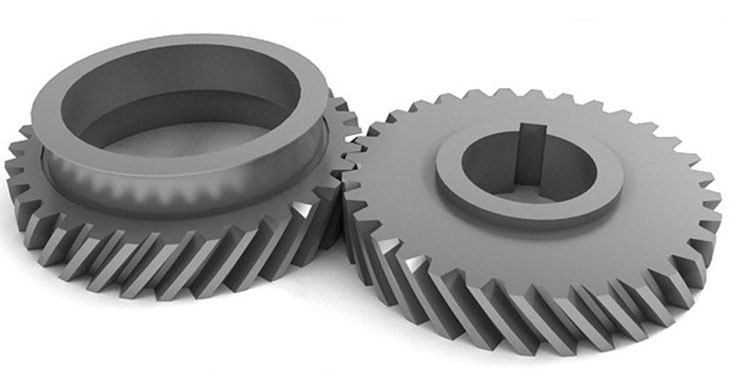
Helical gears are a type of cylindrical gears with helical teeth that are cut at an angle to the gear axis. They are widely used in various mechanical systems due to their smooth and efficient power transmission, low noise levels, and high load-carrying capacity. Here’s an in-depth overview of the design and function of helical gears:
Design of Helical Gears:
- Helix Angle:
- The helix angle is the angle between the gear tooth and the gear axis. It is typically measured in degrees or radians. The helix angle can be either right-hand or left-hand, depending on the direction of the helix relative to the gear axis.
- Module (Pitch):
- The module, also known as pitch, is the ratio of the gear’s reference diameter to the number of teeth. It determines the size and shape of the gear teeth.
- Pressure Angle:
- The pressure angle is the angle between the line of action (the line tangent to the pitch circles) and the line perpendicular to the gear teeth at the point of contact. A common pressure angle for helical gears is 20 degrees.
- Number of Teeth:
- The number of teeth on the gear affects the gear’s size, pitch diameter, and gear ratio.
- Addendum and Dedendum:
- The addendum is the radial distance from the pitch circle to the outside of the gear tooth. The dedendum is the radial distance from the pitch circle to the root of the gear tooth.
- Profile Shift:
- Profile shift is the modification of the gear tooth profile to achieve specific design goals, such as adjusting the gear ratio or improving load distribution.
- Helix Direction:
- Helical gears can have either right-hand or left-hand helix direction. Right-hand helix gears are more common and have a helix that spirals clockwise when viewed from the gear’s end face.
Function of Helical Gears:
- Power Transmission:
- Helical gears transmit rotational power and motion between parallel shafts. As the gears rotate, the helical teeth mesh together, transferring torque and speed from one gear to the other.
- Load Distribution:
- The helix angle spreads the load across multiple teeth, distributing the load more evenly than straight-cut spur gears. This results in smoother and more efficient power transmission.
- Quiet Operation:
- The helical tooth engagement gradually occurs along the gear face, reducing impact and noise compared to spur gears. This feature makes helical gears ideal for applications requiring low noise levels.
- Increased Tooth Contact Ratio:
- Helical gears have a higher tooth contact ratio compared to spur gears. This provides more teeth in contact at any given time, leading to improved load-carrying capacity and higher torque transmission.
- Axial Thrust Management:
- Helical gears produce axial thrust due to the helical angle. To counteract this thrust, helical gears often come in pairs, with one gear having a right-hand helix and the other a left-hand helix.
- Efficiency:
- Helical gears offer high efficiency due to their smooth tooth engagement and reduced sliding between teeth. The efficiency of helical gears can be further enhanced with proper lubrication.
Helical gears are widely used in applications such as automotive transmissions, industrial machinery, power tools, and many other mechanical systems. Their design and function make them well-suited for applications that require high load-carrying capacity, precision, and smooth operation.
